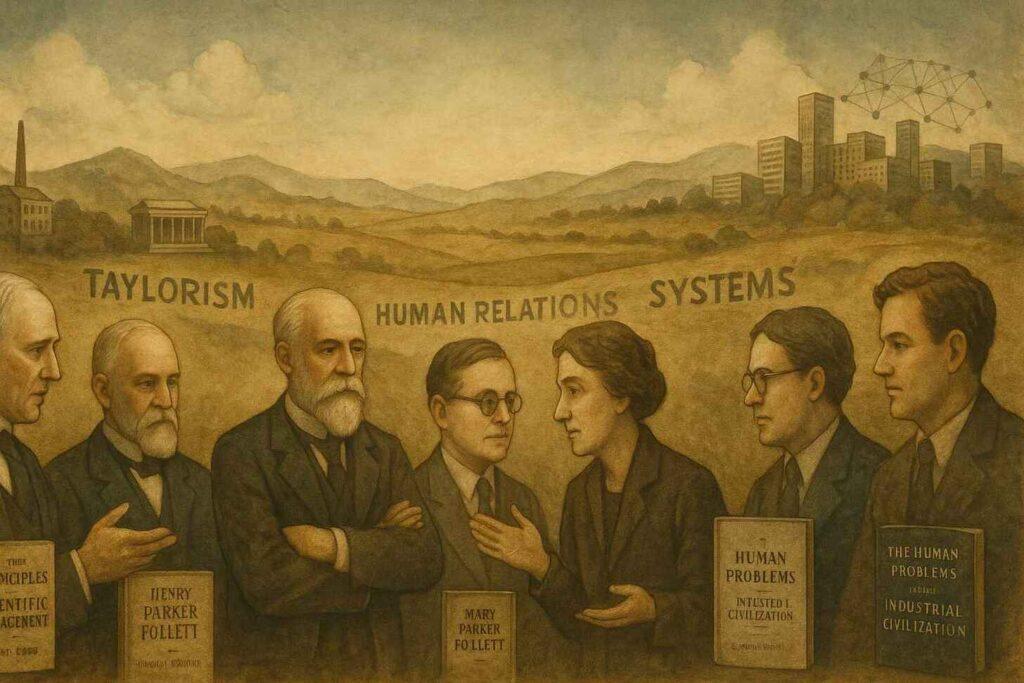Canadian educator and psychologist Dr. Laurence J. Peter came up with a famous idea: the Peter Principle mental model. It says that people get promoted based on how well they’ve done before. But, they often end up in jobs they can’t do well.
This leads to a problem where leaders aren’t good at their jobs. It causes confusion and stops people from reaching their full ability. It’s a cycle of poor leadership and missed chances.
Success in one position leads to advancement—until they hit a ceiling where their skills no longer match the job’s demands.
Imagine a star salesperson promoted to manager. Their ability to close deals doesn’t guarantee leadership skills. This mismatch creates what the theory calls a “level of incompetence”—a point where someone can’t perform effectively. Over time, this cycle affects teams and entire companies, leaving talented individuals stuck in roles that drain their confidence.
Understanding this concept helps you spot warning signs early. It challenges the assumption that past success predicts future performance.
Instead, it encourages focusing on skill development for desired roles rather than chasing promotions blindly. Whether you’re climbing the corporate ladder or managing a team, this tool offers clarity in navigating career growth.
Key Takeaways
- The Peter Principle mental model: Promotions often reward current performance, not future potential
- Skills gaps emerge when roles require new abilities
- Organizations risk inefficiency by overlooking competency mismatches
- Early career awareness helps avoid reaching personal limits
- Past achievements don’t guarantee success in higher positions
Understanding the Peter Principle Mental Model
Promotions can be double-edged swords—here’s why. When companies reward strong performance by moving employees upward, they often overlook one critical question: Does success in this role prepare them for the next in light of the Peter Principle, which suggests that people may be promoted based on performance until they reach their level of incompetence?
Peter Principle Mental Model Key Concepts and Definitions
At its core, this organizational phenomenon occurs when people advance until they reach positions requiring skills they haven’t developed. A 2018 study tracking 53,000 sales professionals revealed a pattern: top performers promoted based on performance to leadership saw team productivity drop by 15% on average.
Why? Their ability to close deals didn’t translate to coaching others, a result that aligns with the idea proposed by Laurence Peter.
| Current Role Strengths | New Role Requirements | Common Gaps |
|---|---|---|
| Meeting individual targets | Developing team strategies | Strategic planning abilities |
| Technical expertise | Conflict resolution skills | Emotional intelligence |
| Task execution speed | Long-term vision setting | Big-picture thinking |
Why It Matters in Modern Organizations
Fast-changing workplaces amplify these challenges. The abilities needed for management roles today differ sharply from five years ago. Teams lose momentum when leaders lack updated skills like remote collaboration or data-driven decision-making.
Smart companies now focus on skill mapping before promotions. They ask: “What specific capabilities does this position demand?” rather than assuming past success guarantees future results, which can lead to the pitfalls of the peter principle and promoted based performance.
This approach preserves both employee confidence and operational efficiency while addressing the level incompetence that can arise from not evaluating performance current.
Why Great Employees Sometimes Fail as Leaders

Promoting top performers seems like a smart move. But, leadership needs a different set of skills. The Peter Principle explains how these high achievers struggle when they face new challenges like coaching or solving conflicts.
A 2019 Harvard Business Review study revealed a shocking fact. It found that 40% of new managers fail within 18 months. This is because they weren’t ready for leadership. This mental model helps companies spot these issues early on.
Applying The Peter Principle Mental Model Today

In today’s work world, managers face new challenges. They must work together online, communicate without being in the same place, and understand people’s feelings. But, many promotions focus too much on being good at one thing, not on working well with others.
A 2023 McKinsey survey found a big problem. It said 61% of HR leaders think the wrong people get promoted. This leads to unhappy teams. The Peter Principle tells us to value being flexible and having good people skills, not just being good at one thing.
Peter Principle Model History and Origins

Why do organizations worldwide repeat the same promotion mistakes decade after decade? The answer lies in a groundbreaking discovery from the late 1960s that reshaped how we view career advancement in business and highlighted the peter principle mental model.
This insight into how organizations promote people reveals critical things about career progression.
Dr. Laurence J. Peter’s Contribution
In 1969, a Canadian educator teamed with writer Raymond Hull to expose a hidden flaw in workplace systems. Their book “The Peter Principle” used sharp wit to reveal how promotions often backfire. Instead of dry analysis, they compared corporate structures to leaky boats—every promoted worker became “another hole in the hull.”
This approach made complex ideas relatable. The authors showed how proven skills in one role rarely prepare someone for higher responsibilities. Their work struck a chord globally, selling millions of copies within months.
The Evolution of the Theory Over Time
Initially dismissed as satire, the concept gained scientific backing over 50 years. A 2019 economics journal article analyzed 131 companies, confirming that top performers often struggle as managers. Schools and military branches recognized similar patterns—excellent teachers promoted to administration, skilled soldiers moved to desk roles.
Forward-thinking organizations now use this knowledge differently. They test leadership abilities before promotions rather than after. This shift helps preserve both employee confidence and team productivity—a lesson learned from decades of observation.
Promotions: From Success to Incompetence
What happens when your greatest strength becomes your biggest weakness? Many organizations reward high performers with promotions, not realizing they’re setting them up for failure. The shift from doing work to leading others requires entirely new skills—a gap that often goes unnoticed until it’s too late.
Performance in Current Roles vs. New Responsibilities
Consider John, a tech specialist praised for his coding speed. When offered a team lead position, he asked: “Do I know how to mentor junior developers?” His honesty revealed a critical truth—excellence in one area doesn’t guarantee readiness for the next level.
This pattern appears across industries. Star teachers become overwhelmed as principals. Sales champions flounder as managers. Why? Their success relied on skills that the new role doesn’t require.
| What Got Them Promoted | What the New Role Needs | Missing Skills |
|---|---|---|
| Meeting personal deadlines | Delegating tasks effectively | Team coordination |
| Technical mastery | Conflict resolution | Communication strategies |
| Individual problem-solving | Strategic planning | Big-picture thinking |
Common Pitfalls in Hierarchical Advancement
Many companies promote based solely on past achievements. A 2022 survey found 68% of managers received no leadership training before their promotion. This oversight creates frustrated employees and underperforming teams.
Smart professionals like John request mentoring programs before accepting new positions. Organizations that provide this support see 40% higher retention rates, according to recent studies on this organizational phenomenon.
The solution? Assess both current performance and future potential. Map required skills for each role. Offer training bridges before promotions—not after struggles emerge.
Teams and Organizational Efficiency Impact

Promotions don’t just affect individuals—they reshape entire groups. When leaders lack critical skills, teams face invisible hurdles that slow progress and drain energy.
Effects on Team Performance After Promotions
A 2018 study tracking 53,000 sales professionals revealed a troubling pattern. Top performers promoted to management saw their teams’ results drop by 15% within six months. Why? Their ability to close deals didn’t translate to coaching others.
Consider a department head who excelled as an analyst. After promotion, their team’s productivity plummeted to record lows. Members filed complaints about unclear directions and missed deadlines. This scenario shows how mismatched skills create ripple effects across departments.
| Before Promotion | After Promotion | Common Impact |
|---|---|---|
| Clear individual goals | Unclear team priorities | Confusion in workflows |
| Proven technical skills | Untested leadership abilities | Declining trust |
| Fast task completion | Slow decision-making | Missed opportunities |
Teams under unprepared leaders often experience higher turnover. One tech company lost 22% of its engineers within a year after promoting a brilliant coder who struggled with conflict resolution. The cost? Lost knowledge and stalled projects.
Smart organizations now track promotion outcomes. They ask: “Are we developing the right skills before moving people up?” This shift helps preserve both employee confidence and operational momentum.
Real-life Examples and Case Studies

Real-world patterns reveal how role mismatches impact organizations. From tech startups to universities, the results often mirror decades-old observations about advancement pitfalls.
Success Turned Struggle: The Tech Firm Example
A software developer thrived for five years solving complex coding challenges. When offered a management role, they hesitated—aware their technical strengths didn’t guarantee leadership skills. By requesting coaching before accepting the promotion, they avoided common traps. Their team maintained 94% productivity during the transition, outperforming industry averages.
Educational Institutions and Leadership Challenges
A renowned professor became department head despite no administrative experience. Within months, staff complaints piled up. Projects stalled as they dismissed feedback and prioritized personal research. This pattern echoes the history of many organizations: promoting based on past achievements rather than future role requirements.
What separates thriving professionals from those who stall? Recognizing when growth requires new tools—not just higher titles. Could pre-promotion skill assessments become as standard as performance reviews?
How to Avoid the Peter Principle in Your Organization

To avoid promoting people to roles they can’t handle, change how you advance people. Move from achievement-based advancement to capability-based planning.
Assess Future Performance, Not Just Past Success
Test candidates in new roles with behavioral interviews and job simulations. Tools like 360-degree feedback give a full view of their leadership skills.
Offer Pre-Promotion Training and Mentorship
Give training in people management, conflict resolution, and decision-making before the promotion. A 2022 Gallup study showed a 25% rise in employee satisfaction in companies that mentored new leaders.
Use Role-Specific Skill Mapping Tools
Clearly outline what each role needs. Match the role’s needs with the person’s skills and training gaps. This makes the transition smoother and keeps employees longer.
Conclusion
The Peter Principle Mental Model warns us that promotions can sometimes backfire. Just because someone is great in one role doesn’t mean they’ll do well in another. This is a key lesson for all of us.
Companies that get this can create better leaders. They focus on who will do well in the future, offer training, and make sure skills match the job.
Whether you’re looking to move up or running a team, understanding the Peter Principle can help avoid mistakes. It can also lead to lasting success.


